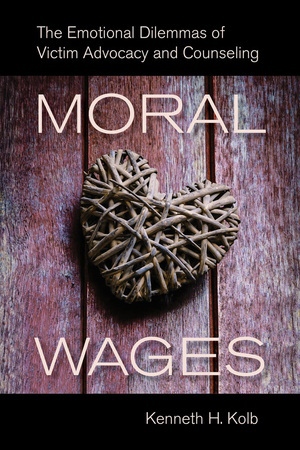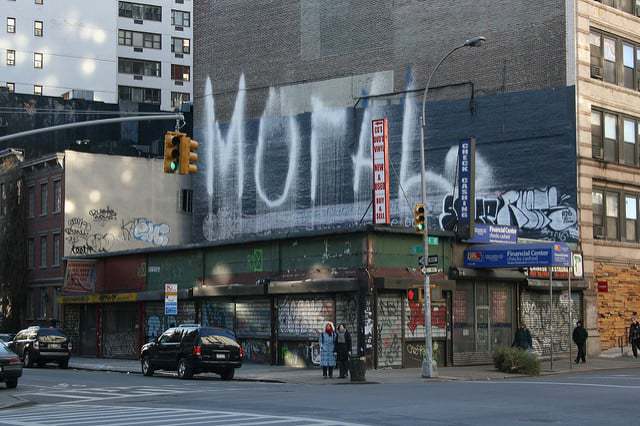I was excited to dig into the book by the sociologist Kenneth A. Kolb. Why? I was keen to read something analytically powerful, critical and innovative about domestic violence (DV) and sexual assault (SA). Globally, DV and SA remain persistent social and health problems as well as violations of human rights. For the most part, a number of academic and non-academic sources circle around the issues, which include victims’ perspectives, cycles in abuse and violence, gender inequality, a variety of multi-sector approaches to recognising and treating victims and perpetuators of DV and SA and awareness-raising actions. Still, I firmly support the need to put a more critical spotlight on the issue of DV and SA in the academic and research spheres.
Kolb has reached beyond the common topics of DV and SA with his work Moral Wages: The Emotional Dilemmas of Victim Advocacy and Counseling.
This monograph is a much-needed (sociological) narrative about the workplace dilemmas of those who struggle on the front line of DV and SA, yet habitually stay at the margins in the discourse: the advocates and counsellors working and volunteering at agencies/organisations around the globe with the aims of preventing abuse, offering services to victims and perpetrators and making other interventions in cases of DV and SA. As the author states, his book ‘is not the first to study battered woman’s shelters or victim support agencies . . . but is unique in that it captures how the inner lives (emotional experiences and identity) of those who work there are shaped by wider forces beyond their control’ (p. 7).
 Kolb begins with the detailed depiction of a staff meeting at Stopping Abuse in Family Environments (SAFE), where budget cuts, excessive workloads and possible work reorganisation were main topics. During the meeting, one of the advocates suddenly began to cry and expressed her feelings of being responsible for a client who had been murdered by her partner (who then turned a gun on himself) a year prior. Through the description of one staff meeting and one (tragic) case in the agency, the reader is given a tangible illustration of the everyday work at SAFE, thereby providing insight into and an indication of the emotional dilemmas faced by advocates and counsellors, as well as victims of DV and SA on a daily basis. These include how to manage workloads that continue to increase in the context of intense budget cuts (where reducing their services was not an option they considered), how to stay motivated for the task of performing this very demanding ‘moral dirty work’ (p. 23) despite the low wages and lack of financial benefits, how to bear the constant emotional risks and pressures of helping and supporting the victims, how to cope with feelings of powerlessness, being responsible for clients’ deaths or the reoccurrence of returning to abusive relationships (Kolb sees self-blame, guilt and shame as occupational hazards at SAFE), how to follow the agency’s central principle of empowerment, how to cope with clients’ ‘difficult’ behaviour (p. 87) and similar issues. All of the questions that Kolb raises are relevant and applicable to other agencies like SAFE.
Kolb begins with the detailed depiction of a staff meeting at Stopping Abuse in Family Environments (SAFE), where budget cuts, excessive workloads and possible work reorganisation were main topics. During the meeting, one of the advocates suddenly began to cry and expressed her feelings of being responsible for a client who had been murdered by her partner (who then turned a gun on himself) a year prior. Through the description of one staff meeting and one (tragic) case in the agency, the reader is given a tangible illustration of the everyday work at SAFE, thereby providing insight into and an indication of the emotional dilemmas faced by advocates and counsellors, as well as victims of DV and SA on a daily basis. These include how to manage workloads that continue to increase in the context of intense budget cuts (where reducing their services was not an option they considered), how to stay motivated for the task of performing this very demanding ‘moral dirty work’ (p. 23) despite the low wages and lack of financial benefits, how to bear the constant emotional risks and pressures of helping and supporting the victims, how to cope with feelings of powerlessness, being responsible for clients’ deaths or the reoccurrence of returning to abusive relationships (Kolb sees self-blame, guilt and shame as occupational hazards at SAFE), how to follow the agency’s central principle of empowerment, how to cope with clients’ ‘difficult’ behaviour (p. 87) and similar issues. All of the questions that Kolb raises are relevant and applicable to other agencies like SAFE.
Kolb introduces the concept of ‘moral wages’ as an analytic device to answer some of the above-stated dilemmas, where ‘the moral wages are not just individual experience, but rather patterned forms of symbolic compensation that are structurally embedded into occupations like victim advocacy and counseling’ (p. 50).
He also uses the concept ‘to offer a different perspective on what factors can impede and enable workers’ ability to “feel good” about doing good’ (p. 50) and to explain ‘how workers with higher and lower incomes make sense of their decisions to put up with less’ (p. 50).
Further, the author analyses service providers’ dilemmas arising out of the concept of ‘empowerment’, a philosophy that is often embedded in non-government organisations (NGOs) policy. It is about ‘helping others by offering them the time, resources, and encouragement they need to make their own decisions’ (p. 53), in the process of ‘regaining strength, courage, confidence and personal power’ (p. 54). This is a ‘hands-off’ guiding practice for treating victims of DV and SA and not ‘rescuing’, blaming or judging them.
Only in cases of imminent danger do staff members have the permission to intervene and give explicit advice to clients. Empowerment is also an interpretive filter for the evaluation of the work at the agency. However, as Kolb skilfully demonstrates, in practice, empowering clients is a challenging goal, also provoking work dilemmas and personal doubts. He introduces ‘the steering strategies’ (p. 71) staff members use as a support tool to ‘nudge clients off a potentially hazardous path’ (p. 71).
The myth of the ‘perfect victim’ is another crucial concept he analyses. The myth causes societal misconceptions about DV and SA, but as the author also points out, ‘the trope of ideal victims put abused woman in an inescapable double bind’ (p. 102). Debunking popular perceptions and myths about victims is a decisive part of SAFE’s job. As staff members significantly emphasised, real-life victims of DV and SA are not always the sad and stoic figures portrayed by the media or awareness-raising campaigns (similarly, the image of the aggressive man, the ‘perfect perpetrator’, is only a myth). Sometimes, staff members must deal with clients who demonstrate so-called ‘difficult behaviour’. Kolb gives a detailed portrayal of one such ‘difficult client’, who repetitively lied, missed sessions, returned to abusive men, spent money that SAFE had given her for living costs and education to buy and sell drugs, argued aggressively with pro-bono lawyers, yelled at officers and so on (see Chapter 4). At this point it is crucial to stress that the actions of not respecting safe house and agency rules/principles endanger victims and staff members and can damage the agency’s reputation among the local community and other competent institutions (such as police departments, social work offices, court houses and so on). Yet Kolb carefully elaborates on staff members’ dilemmas, how to handle, tolerate, sympathize with, set limits or even refuse the services of the most difficult clients and those who practice risk-enabling bad behaviour.

Further Kolb examines the dilemmas arising out of the criminal justice system. According to Kolb, staff members perceive it with much suspicion; they view arrest warrants and restraining orders with caution, as legal victories might give clients a false sense of security or enrage the woman’s abuser or both (see p. 113). In the context of empowerment, they understand the legal system as a potential threat ‘to take away clients’ “power and control” over their lives’ (p. 114). Another concern they express is in regards to the effectiveness, especially of protective orders. Kolb states that the rhetoric about protective orders as being only a piece of paper is part of a wider, nationwide discourse. The author’s auto-ethnographic descriptions of legal work reveal much about the staff members’ dilemmas, symbolic meanings, wider social context of dealing with DV and SA and satisfaction arising from the task of accompanying a client to the court house and winning a protective order.
One of the central questions throughout the book illuminates that of gender issues;although all people might be affected, women are predominantly the victims, as well as support services staff members (e.g. NGOs, social workers, and so on) for DV and SA victims.
He talks about the fact that woman are traditionally expected to perform the emotionally demanding work (and professions) of caring for others, such as listening to, comforting, exhibiting compassion, caring for the needs of others, and so on. This ‘women work’ (p. 138) comes with few symbolic and financial rewards.
As a man, the author was an exception in mainly female workplaces, where women are frequently stereotyped as ‘feminazis’ (p. 20) or man-haters. As a man who got involved in helping victims of DV and SA, he rapidly earned privileges and merit badges. As he observes, ‘countless woman did more for clients than most men (myself included) ever did, yet none of these women ever received the same amount of applause for simply “being there” or “showing interest”’ (p. 160). Because the implications of such and similar practices at places like SAFE contribute to the reproduction of gender inequality, Kolb suggests that both institutions and individuals ‘stop privileging men’ (p. 178).
In the conclusions, the author gives precise advice for modifying and standardising existing practices and putting them into policy. A comprehensive account of fieldwork methods and research strategy is also given at the end (Kolb spent four months in training and volunteering at one agency and later made observations and in-depth interviews at another for fourteen months).
I think that the book’s primary strengths are Kolb’s straightforward and thick auto-ethnographic descriptions (my admiration might stem from my training as an anthropologist) of his personal journey into the sphere of DV and SA. He vividly illuminates his experiences of entering into the ‘women domains’ and being slowly integrated into the agency. After he gained the trust of the residents and his co-workers, ‘being a man made my research easier’, he writes (p. 142). What is important is that through his personal accounts he managed to lucidly portray the social construction of DV and SA, positioning the related problems within the wider contextualisation of gender issues and the process of stereotypisation.

Kolb also proved to be a careful observer, as he skilfully writes about the challenging dilemmas, workloads and emotional hazards individuals face on a daily bases in SAFE. Based on his professional background, he embraces different sociological references and analytical concepts (such as moral wages as a subset of DuBois’s term ‘psychological wage’, steering strategies, moral identity work, sympathy, Goffman’s ‘cooling out’ and others) to put SAFE’s work concepts and philosophy into a different perspective and frame of understanding. As much as I found his detour from the dominant contextualisation of DV and SA – that is, the cycle of abuse in violent relationships – one of the innovations in the research, it is also a theoretical framework I missed in a few parts of the book. I am not saying that the cycle of violence is completely left out of the analyses, I would only suggest it is not stressed enough as the fundamental theoretical framework that staff members at NGOs use for the understanding of a victim’s (difficult) behaviour. It is also one of the imperative conceptual tools they use for solving several work and emotional dilemmas (such as efficiency, motivation, self-blame, responsibility, and so on).
Most importantly, Kolb’s research is in many ways an innovative contribution to the studies in DV and SA.
It might be interpreted as a nuanced praise of everyone who on a daily basis performs the emotionally demanding work of helping others with little (or no) financial benefits or privileges (I sensed Kolb’s sympathy and admiration for the hard work of advocates and counsellors throughout the research). I would definitely recommend the book, even to those outside the professional community interested in DV and AS. Not only are topics like gender inequality, ‘women work’ and ‘moral wages’ transferable to many other spheres, but also many will find the monograph stimulating; to a careful reader, it gradually opens up the social and individual complexity of DV and SA. I am referring to a myriad of horizons that are impossible to grasp in the review with a 1500 word limit.
Kolb H. Kenneth. 2014. Moral Wages. The Emotional Dilemmas of Victim Advocacy and Counseling. University of California Press. 232 pp. Pb.: $29.95. ISBN: 9780520282728.
**********
Featured image (cropped) by rogiro (flickr, CC BY-NC 2.0)



